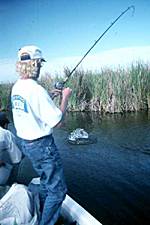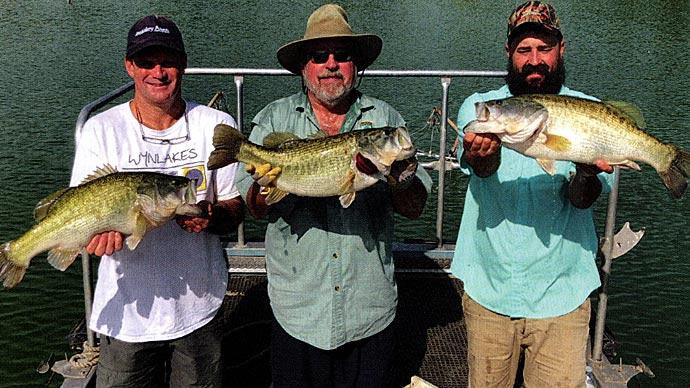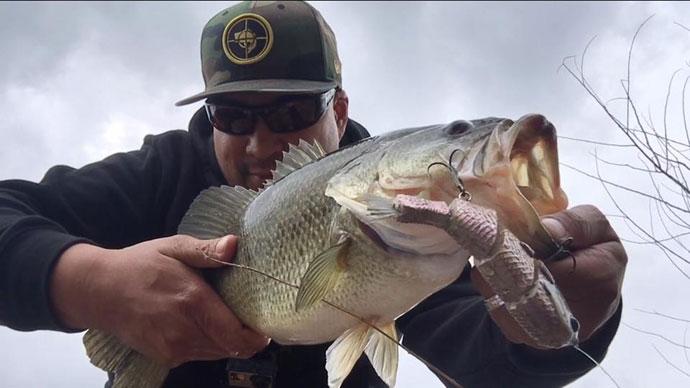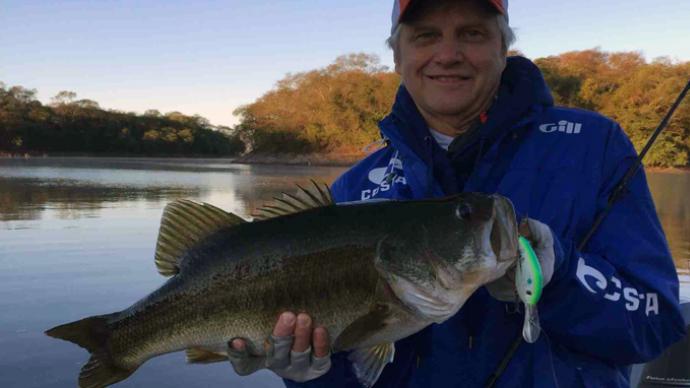
I was recently fortunate to fish for bass in Mexico. Many anglers read of the excellent bass fishing 'South of the Border' but usually think it must be a sales pitch. "No fishing could be that good!" they think. Well, they should think again. For me, it was exciting and successful. I may have even gotten a fleeting glimpse of something close to that elusive World Record.
The photo (left) is Bryan Hague, my host, and owner of Westside Fishing Adventures, with my largest bass from Mexico's Lake Espanola. The color is poor due to rainy skies and lack of sunlight (you know I would forget the flash!). We did not have a scale with us either. But she was a 'big Mucha-cha,' you betcha!!! We were lucky enough to see several big fish that particular day. But they got big by getting away, and our success landing them that day fully supported that.
The problem was that we were hunting elephants with a BB gun. Our hooks just weren't large enough for their giant mouths!!
I don't sell fishing trips to Mexico and am not employed by anyone who does. So, what I will present to you in the following paragraphs is my 'Trip Report,' if you will. I will also provide a point-of-contact if you want to explore the Mexico thing further.
The excuse to make this trip to Mexico was a request from an outfitter and a fishing lodge owner to evaluate the bass fishing potential in two locations and determine how best to catch the fish in large numbers and strictly fish for trophies. We agreed that I would help them with the fishing techniques, and I might write an article about the trip if the fishing warranted it.
It warranted it, and I did, as you are reading!!
Airfare from Orlando, Florida, to Tampico, Mexico, included a plane change in Houston (1 hour and 27 minutes from Houston to Tampico). I arranged and paid for my airfare. Outfitter Bryan Hague, Todd Collier of Luxury Largemouth Lodge, and Guillermo 'Bill' Pier of Real Viejo Lodge provided in-country transportation and room and board. They also provided boats, motors, and guides.
To locate Tampico, look at the Texas map and note Brownsville at the tip of the State and on the Gulf coast. Now, go south along the coast for some 300 miles, and you'll find Tampico. Of some 280,000 residents, this city is usually more known for its superb saltwater fishery. For example, there is an annual fishing tournament week sponsored by their city fishing committee. It takes a 30-pound snook, a 190-pound tarpon, and similar obscene weights in the other species to win. Bass are second-rated by the locals, but they still have a category for them. The winner is usually around 8 pounds (perfect for semi-tidal waters). Bryan has since started a snook guide service. I left him all my magnum Rat-L-Traps, jerkbaits, and topwaters. This is an excellent snook fishery; it will be an excellent fishing trip once Bryan gets it together correctly.
Our first stop was the Laguna ('lagoon') Tortuga. A flat land area creates this vast marsh sandwiched between some small hill masses on three sides and a salt marsh leading to the Gulf of Mexico on the other. It was probably a salt marsh, itself, eons ago. Right now, it will remind you of Back Bay in Virginia, and maybe certain outer areas of Currituck and Pamlico Sounds below Back Bay. It is similar to the vegetated west wall of Lake Okeechobee in Florida -- lots of coontail grass, eelgrass, pepper grass, and what appeared to be at least 1/2 of the reeds known to exist in the World. Boat runs in some reeds are like the old Pig Trail near North Cove in Florida's Lake Kissimmee. The water averages 6 feet deep, with some locations approaching 8-9 feet. The water is very clear, except in a tiny section that is continually stained for some unknown reason (that stained water area is a BIG bass location, too!). The bottom composition is hard to sand, with an abundance of gravel and muck (in some areas) from decaying vegetation.
In keeping with what might be expected of a shallow, heavily-vegetated body of water, Laguna Tortuga is a phenomenal topwater fishery, especially if there is a breeze and a slight ripple on the water. There was no particular topwater method that was better than another. Buzzbaits were great, even after dark (you just listened and felt for the strike). Most any style of the topwater plug was fine, too. With great success, I used a Pop R, a Spittin' Image, a Zara Spook, and a Devil's Horse. Bryan used a lure called a 'Yellow Magic', similar to the Pop R, which Texas anglers may recognize. That was a killer topwater lure!! I even had bass hitting a Pop-R that was covered in grass. You couldn't even SEE the lure. But it was moving, and that was all that counted. Once, as I was speed-reeling the lure in to clean the weeds off, a giant bass hit the mass of weeds and lure right at the boat. Big bass on 2 feet of line are NOT conducive to landing.
While Bryan Hague was fishing a giant plastic lizard and large slip sinker, I went with my standard 4-inch worm and a 1/16-ounce slip sinker. Bryan's heavy rig was ideal for flipping into the edges of the reed stands but was not well suited to the submerged vegetation in the open water. The small worm and lighter weight were ideal and produced a strike on nearly every cast. I went 27 straight casts with a fish on during one period. This small worm rig, coupled with the topwater applications, gave us the quantities of fish we were striving for. Our catch during the 7 hours we fished was 129 bass. Add to that what we lost or shook off, and the number is staggering.

The next day, we went to different lagoon sections and tried other methods. Spinnerbaits worked very well. I used the standard white, and Bryan had a chartreuse and green combination. The strikes were solid and engulfing, with no trailer hooks needed. We also found that flipping Bryan's giant plastic lizard, a 7-inch worm or a big jig, into the reed edges produced larger bass more consistently than the outer, submerged grass beds. Bryan took an 8-pound fish, and we had three others that appeared to be larger in an hour or so we spent at this method.
We also experimented with a swimming worm rig that I learned from tidal water anglers. In general, it consists of a short heavy length of monofilament line with two small, strong hooks tied about 3 inches apart. A 6-inch floating (very firm and straight) style worm is threaded on - one hook into the head of the worm and one placed simply through the worm's tail about an inch from the end. This makes the worm lay in a crescent or half-moon shape. When pulled through the water, the lure spins in a corkscrew fashion and looks very much alive. The rig is about 18 inches long, and a good swivel is tied at the front of the line. A 1/8-ounce split shot just below the swivel completes the rig. Casting and retrieving this lure configuration is much like fishing a spinnerbait. You toss it near cover and retrieve it slowly and steadily back to the boat. This was a devastating lure in the lagoon, with great potential for the larger bass. The lodge made some up since most anglers will never have seen one. Ask for it if you happen to be there.
Our next stop was about 50 miles inland to the north-northwest from the lagoon at Lake Espanola. Lying in a region of low mountain foothills, Espanola is different from the lagoon we had just fished. Comprising some 6000 acres (3000 of which have standing timber), Lake Espanola is formed by damming a small river in a mountain valley. It has approximately six submerged feeder creek channels intersecting the submerged river channel at various points. The water is clear but slightly less so than the Laguna Tortuga. The bottom structure is rock, sand, and gravel. The shallows, especially in the timbered areas, contain large amounts of coontail grass. There may be some Eurasian milfoil, but it wasn't easy to tell. There was no eel grass that I saw. The lake was approximately six feet low due to a lowering of the water level to work on the dam. The surrounding landscape is stunning!! The mountains are low enough to be covered in greenery, except for bare rock caps. The entire countryside was lush, and the air was clean and sweet. This is also a World-class dove hunting area.
Lake Espanola appears to offer trophy bass fishing to stun the imagination. We were told that Lake Espanola had not been fished for bass in eight years and that only a few Mexican locals had come to its waters before that. 'Eight years' would be before the 'big interest' in the bass fishing bonanza Mexico offers, so we assume Espanola has never been seriously fished by any Americans. We were the first! It did not disappoint us.

The ideal way to fish Espanola for its bigger bass appeared to be to go to the timber areas. We did this and, initially, attempted to stay close to the deep water access of the submerged river or creek channels when possible. With grass just under the water's surface, we again brought out the topwater lures and the small, lightly-weighted worm. Both worked great, with the larger bass opting for the topwater plugs. We also found that jerk baits, such as the Sluggo-style soft plastics and the Rogue-type stick lures, were very effective. We took bass to 7 pounds in these locations but had (what we think were) larger ones come off the lures in the grass.

Later, we moved away from the channels and back into the more dense timber. This proved to be a bad move for the hearts of us older guys. I had three bass over 10 pounds to take topwater lures. One was so huge that I could not believe what I was seeing. Although it came off the Pop R lure in the timber, this giant appeared to be MUCH larger than the 15-pound largemouth I caught and released in Florida's famous Farm 13/Stick Marsh a few years back. The swirl of the bass was equal to any eight-foot alligator I HAVE SEEN in Florida. I asked if there was anything, other than a bass, that would have made that size water movement, and the guide absolutely said 'no.' Simply dropping a worm around any wood also brought rapid strikes. The fishing camp owner advised us that this was the 'slower' part of the year and that spinnerbait and topwater fish would REALLY get hot in February through April (I am not sure I could stand it any 'hotter'!).
We fished Espanola for five hours, and our total catch was approximately 40 bass. We also had about six trophy opportunities during that period, a pretty good ratio!
Our time did not allow us to explore the deeper open-water sections of the lake (up to 100+ feet near the dam) and its many submerged channels. Had we applied our depth finder to these areas for a day, we could have located large schools on and near the channel drop structures and other submerged features. Deep crank plugs and Carolina rig worms would have then been the tickets. This remains a mystery to be explored and solved, and I look forward to it like you would not believe!!
A key point in pursuing the Lake Espanola giants is that "you can't catch sharks with a safety pin" (i.e., you need something with HOOKS on it). Hey, a Pop R has great, sharp hooks, and a big bass will readily hit a lure the size of the Pop R, but those hooks are not big enough to ensure snagging a truly BIG bass well enough. My next trip to Espanola will involve using saltwater plugs and the biggest spinnerbaits I can find (Musky-sized, I expect). I am sitting here looking at a box of Creek Chub, Rebel, and Bomber saltwater lures I got from PRADCO today. I am reminded that my Daddy once said, "Don't hunt bears with squirrel shot." Understood, and I WILL comply.

So that you know, the Laguna Tortuga is a 'best bet' for the angler who wants to catch LOTS of bass. For the angler who loves surface action, it is a topwater Mecca. It has a vast population of small bass, which means great fishing for many seasons to come. The better locations for the large quantities of bass were the slightly deeper areas of open water where the submerged grass was 2-3 feet beneath the surface. That allowed the lures to work across the top of the grass efficiently. But, there was NO place in that entire lagoon where I did not catch fish at will. There are that many fish. A trophy is always possible in the lagoon, and the best way to find that fish is to flip or work tight to the reed stands with large plastics and jigs. An excellent American-operated lodge sits at the water's edge, with the boats ready and waiting nearly at your door.
Lake Espanola is a trophy bass lake. I saw the big bass it holds and expect the lake record of 17 pounds will not last long once fishing re-starts. I hesitate to say it is a 'hundred bass a day' lake until I work the deeper structures for schools and prove it to myself. However, there is no doubt in my mind (none whatever) that a good structure fisherman with a depthfinder can catch unlimited numbers of bass, and they will undoubtedly be quality fish. The rustic lodge on Espanola is currently undergoing a complete renovation and is due to re-open in early February 99. The owner, Guillermo Luengas Pier ('Bill' to his Gringo friends), was a previous head of the Mexican Government's fishery department. He was the architect and overseer of the Florida-strain stocking program across Mexico. When he says, "Espanola was heavily stocked over the years, " I expect that statement to have excellent credibility.
For more information on the lagoon and Espanola, you can email me at jporter@palmnet.net, and I will attempt to field the questions I can. For other sections of Mexico, try going to a search engine and entering 'bass fishing, Mexico'. You'll get all sorts of good information that will make you nervous and sweaty!
Let's see, my 'going back' inventory: 100-pound test Fireline, 10/0 worm hooks, a few 22-inch Culprit worms, some 10-inch topwater poppers, my heart pills ------ !!!! Now, where are those plane tickets?
Jim is a widely-published author, outdoor writer, and trophy bass guide on Florida waters. Having chased largemouths and smallmouths in Spain, Italy, France, Mexico, and nearly all 48 contiguous States, he is a recognized authority on bass fishing. He has been widely published in nearly all fishing-related publications, including Bassmaster magazine. Jim is also active on numerous Internet Web sites. His 'how-to' fishing articles, 'Ask A Pro' query sessions, and advise/technique columns have assisted numerous anglers improve their skills and fishing success. His most recent publication, "The Hungry (but lazy) Mans' Recipe Book (and other assorted stuff!)", has been acclaimed for its fishing wit, wisdom, and gastronomic value.



